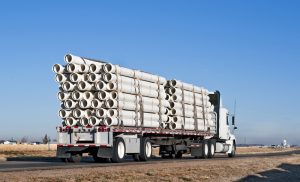Divisible VS Non-Divisible Loads
Divisible loads can be broken apart easily, while non-divisible, or indivisible loads generally take more than 8 hours of work to disassemble. It is usually possible to obtain a permit for an indivisible load, but divisible loads have to follow weight regulations.
Hauling divisible vs. indivisible loads makes a big difference in the type of weight regulations that a trucker has to follow. Let us explore both divisible and non-divisible loads.
Divisible Load
A “divisible load” is any vehicle or combination of vehicles transporting a cargo of legal dimensions that can be divided into units of legal weight without affecting the physical integrity of the load. Some of the divisible loads are topsoil, sand, gravel, scrap metal, stone, fuel, logs, trash/refuse/garbage, etc. The main goal of this type of loads is to minimize one’s ability to overload cargo onto a trailer. If the cargo/components being shipped can be divided into many units of legal dimensions without affecting the physical integrity of the load, then they must be separated if they fall outside of the “legal dimensions” of the state. If it can be divided and it does not exceed 8 – man hours to disassemble it, then it must be separated.

Here are the 4 dimensions where Divisible Load Law will apply, listed from top to bottom in the likelihood of enforcement from state to state. Use the category that best describes your load to help determine if it is feasible to transport on one trailer.
Please note: It is extremely important to contact the individual states you will be transporting through for verification of state-specific regulations.
| Uncommon – Total length of the load cannot exceed state maximums if the other pieces add to the length. They must be transported distinctly. |
| Very Uncommon – Total height cannot exceed the state maximums (rule of thumb 13’6’’ east of the Mississippi and 14’ west of the Mississippi) this would be a rare case because most items are not loaded if they transported in many pieces rather than side by side. |
| Somewhat Common – Total width of the load cannot exceed 8’6’’. If there are two pieces and one causing the width to exceed 8’6’’ they have to be separated. |
| Very Common – Tractor, Trailer, and Load total weights cannot exceed 80,000 lbs. If there are two pieces that cause the overall weight to exceed 80,000 lbs., then they must be divided. |
OverweightPermits.com is happy to help you obtain your divisible load permits. Don’t hesitate to call us and we’ll get you on your way. Give us a call at
Non-Divisible Load
Hauling divisible vs. indivisible loads makes a big difference in the type of weight regulations that a trucker must follow. Usually, non-divisible loads are loads that can’t be divided easily to comply with weight rules. Permits may be issued by the States without regard to the axle, gross, or Federal bridge formula requirements for non-divisible vehicles or loads.
A non-divisible load is defined as any load or vehicle that exceeds applicable weight or length limits which, if divided into smaller loads or vehicles, would:
- Compromise the intended use of the vehicle, i.e., make it unable to perform the function for which it was intended;
- Destroy the value of the load or vehicle, i.e., make it unusable for its intended purpose; or
- Requires more than 8 work hours to pull to pieces using appropriate equipment. The applicant for a non-divisible load permit has the burden of proof as to the number of work hours needed to pull the load into pieces the load.
Emergency response vehicles may be treated as non-divisible loads by state, including those vehicles which are loaded with sand, salt, chemicals or a combination thereof, with or without a plow or blade attached in front. Also, those which are being used for spreading the material on highways that are or may become slick or icy; casks intended for the transport of spent nuclear materials. Military vehicles transporting marked military equipment or material.
Superload
A super load is over-dimensional such as oversized hauls. Though, a super load will exceed an oversized load in either width, height, length or weight. A super load can’t be divided or broken down to reduce its size. A super load is generally pieces of extremely heavy and large equipment. Super loads, transporting equipment’s are cranes, vessels, structures, etc.
In addition, different states will define a super load differently. For example, in Massachusetts, a super load is 130,000 lbs. In Pennsylvania, cargo that surpasses 201,000 lbs. is a super load.
Superload Permits with OverweightPermits.com
When you are transporting a super load, you need experts on your side for this compound planning. OverweightPermits.com’s highly skilled team of permit agents will survey your route state by state, highway by highway to guarantee that every underpass and bridge crossing can admit the size and weight of your super load.
OverweightPermits.com maintains all-inclusive route databases and fosters relationships with state and local government offices to ensure accurate and timely service. Our team runs through the entire route and offers alternates wherever the infrastructure may be insufficient to handle your super load.
Ship Your Super load in a Safe and Timely Manner
Hauling wide and heavy loads across the U.S. is not an easy deal. This is particularly true for Super loads. Superloads are loads that surpass a state’s routine permit standards (in height, length, width, or weight). It’s not an exaggeration to say that Super loads are the Major League of heavy haulage.
Why OverweightPermits.com Is the Best Super Load Permit Provider
At OverweightPermits.com, we don’t shy away from big challenges. Superloads are complex and demanding. There are always different obstacles and limits thrown your way. You need an agency that can surely navigate this in a safe and timely manner. Contact us at (888) 799-8858 today to learn how we can help you. You can also fill out our quote form which is on our website.




